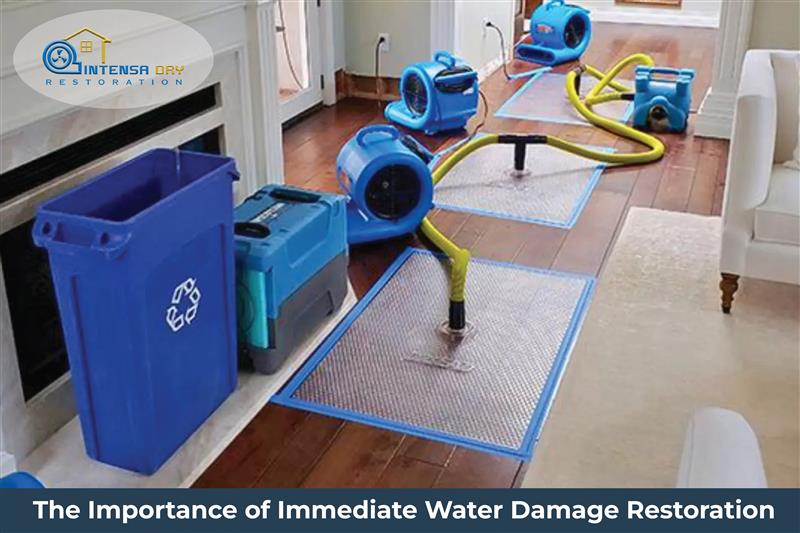Blogs
The Importance of Immediate Water Damage Restoration

Water damage can strike when you least expect it—whether from a burst pipe, a leaky roof, or sudden flooding. Many homeowners underestimate the urgency, thinking it can be handled “later.” But when it comes to water damage, time is your biggest enemy. The longer you wait, the more the damage spreads, the more the cost rises, and the more the health risks increase. Acting immediately doesn’t just save your property—it safeguards your family’s health, prevents mold outbreaks, and helps you avoid long-term structural issues. In this guide, we’ll walk you through why immediate water damage restoration is so critical, what happens if you delay, and how professional restoration services can make the process stress-free and effective.
Water Damage Escalates in Hours, Not Days
Water damage is sneaky. Within the first hour, water can seep into walls, flooring, and furniture, starting a chain reaction of destruction. Drywall can absorb moisture like a sponge, while wooden floors begin to swell and warp. By the 24-hour mark, odors set in, mold spores start germinating, and structural materials weaken.
Quick action prevents what experts call “secondary damage.” Secondary damage isn’t just visible stains—it’s hidden deterioration that compromises the safety and value of your property. If left untreated for days, restoration costs can double or even triple, as you’ll likely need extensive repairs and mold remediation.
The Health Risks of Delaying Restoration
Water damage isn’t just about property loss—it’s a health concern. Standing water and excessive moisture create a perfect environment for mold and bacteria to thrive. Mold can begin forming in as little as 24 to 48 hours after water exposure, releasing spores into the air that can cause respiratory problems, allergies, and even more serious conditions for those with compromised immune systems.
Additionally, water intrusion can carry contaminants, especially if it comes from a flood or a backed-up sewer line. These contaminants can make your home unsafe to inhabit without professional cleanup. The longer you wait, the more dangerous the environment becomes for you and your loved ones.
Protecting Your Home’s Structural Integrity
Your home’s foundation, walls, and support beams are designed to be strong—but water can weaken them faster than you might think. Moisture causes wood to rot, metal to corrode, and concrete to erode. Even if the damage isn’t visible right away, hidden water pockets inside walls and under flooring can silently eat away at your home’s structural integrity.
Immediate restoration ensures that professionals use moisture detection tools to locate hidden dampness. This not only stops current damage but also prevents future problems like sagging floors or unstable walls—issues that can be costly and dangerous to fix later.
The Role of Professional Water Damage Restoration
While DIY cleanup may seem tempting, professional water damage restoration services are equipped with advanced tools and training to handle the problem thoroughly. Experts use industrial-grade pumps, air movers, and dehumidifiers to extract water and dry affected areas completely. They also have the expertise to assess which materials can be salvaged and which need replacing.
Professionals follow industry-standard protocols to ensure your home is not only dry but safe. They perform mold prevention treatments, sanitize affected areas, and document the restoration process for insurance purposes—something that’s crucial if you plan to file a claim.
Financial Benefits of Acting Immediately
Restoring water damage quickly can significantly reduce costs. When you act fast, you minimize the need for expensive repairs like tearing out walls, replacing flooring, or doing mold remediation. Most insurance policies cover water damage restoration if it’s reported promptly, but they may deny claims if the damage worsens due to homeowner neglect.
By calling professionals immediately, you also protect your investment. Your home is likely your biggest asset, and quick restoration ensures its value remains intact. Think of it this way—every hour you wait could be costing you more in hidden damages.
Immediate Action: Save Personal Belongings
Beyond structural concerns, water damage often affects cherished belongings like photographs, furniture, and electronics. The sooner you remove and dry these items, the higher the chance of saving them. Professional restoration teams can help salvage important possessions using specialized drying and cleaning techniques.
Items like rugs, upholstered furniture, and wooden cabinets can often be restored if addressed within the first 48 hours. However, waiting too long may lead to irreversible damage and sentimental loss.
Steps to Take Before Professionals Arrive
While waiting for the restoration team, there are safe steps you can take to minimize damage. Turn off the water supply if possible, remove items from the affected area, and avoid walking on wet surfaces to prevent accidents. Never attempt to use household fans or heat sources to dry large-scale water damage, as improper drying can trap moisture and cause mold growth.
Instead, focus on safety first—keep electrical appliances away from water, and avoid contaminated areas until they’re properly cleaned.
Final Thoughts
Water damage restoration is a race against time. Acting immediately protects your home’s structure, preserves your belongings, reduces health risks, and saves you money in the long run. With the right professionals by your side, the process can be efficient and stress-free. Don’t let water damage spiral into a bigger disaster—respond promptly and protect your investment, your health, and your peace of mind.
FAQs
1. How quickly should I call a water damage restoration company?
You should call as soon as you notice the damage—ideally within the first few hours—to prevent further issues.
2. Can I clean up water damage myself?
Small spills can be handled by homeowners, but significant water damage should always be addressed by professionals for safety and thoroughness.
3. Will my insurance cover water damage restoration?
Most policies cover sudden and accidental water damage, but coverage may be denied if you delay action or the damage results from neglect.
4. How long does water damage restoration take?
It depends on the severity. Minor cases may take a few days, while major restoration projects can last one to two weeks.

